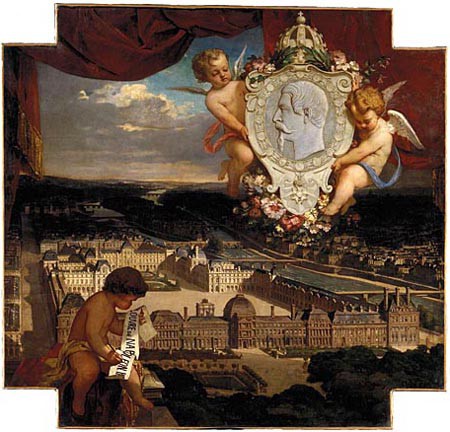On 14 August, 1857, the formal inauguration of the “Nouveau Louvre” took place. This new-look Louvre was in actual fact the amalgamation into a single unified palatial complex of the Louvre and the Palais des Tuileries, an accomplishment that confirmed Napoleon III arrival amongst the ranks of the great French monarchs. “The completion of the Louvre,” he announced “is not simply a passing whimsy but the realisation of a plan which was conceived in the name of glory and has been maintained by the country’s desire for more than three-hundred years.” This magisterial endeavour is celebrated in the allegory painted by Victor-Joseph Chavet. The portrait of Napoleon III in profile, around which hangs a sculptured medallion in the form of the Grand Collar of the Legion of Honour and above which appears the imperial crown, is born by two winged cherubs and takes an aerial view of the palace. A third cherub, seated this time, completes an inscription immortalising the sovereign’s name. The architectural accuracy and precision in the painting is supported by photographs taken at the time; these are all that remains of the Palais des Tuileries which was burned down in 1871.
This painting is in fact a tapestry cartoon (a full-scale design for said tapestry) which was commissioned in 1855 and completed in 1857. Following a decree on 22 November, 1851, twenty-eight tapestries were actually commissioned, to be produced by the Gobelins Manufactory, and destined to hang in the Galerie d’Apollon in the Palais du Louvre. All were to depict the men, kings, architects and artists who had, over the centuries, contributed to the completion and edification of the building. This commission formed part of a wider restoration programme that had been initiated in 1848 and which was finally completed in 1851, with the reopening of the gallery. On 16 October of that same year, the Prince-President personally presided over the inauguration of the Delacroix painting, Apollon vainqueur du serpent Python. Ten years later, it was the French Crown Jewels and the collection of enamelware and gold which would find their home in the Galerie d’Apollon, where they remain to this day.
The tapestries, the cartoons for which were produced by some twenty painters, were completed between 1853 and 1864. The tapestries themselves run along the entire length of the room. At the centre, arranged opposite each other in two pairs, are four panels depicting the four monarchs to have had the greatest impact on the Louvre’s history: Philip II, Francis I, Louis XIV and Napoleon III. This last tapestry was replaced in 1887 by one glorifying Henry IV.
Karine Huguenaud (tr. & ed. H.D.W.)
Click here for the mini-site produced by the Louvre, which covers the history of the Galerie d’Apollon (external link).
February 2010


